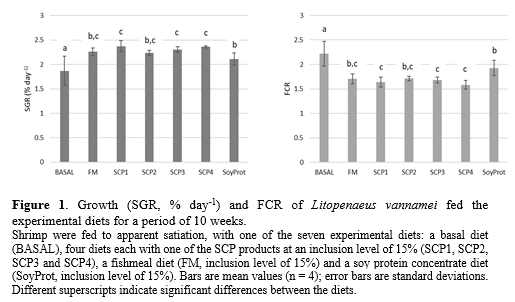EFFECT OF DIFFERENT TYPES OF SINGLE CELL PROTEIN ON FEED INTAKE, GROWTH, BODY COMPOSITION AND DIGESTIBILITY OF WHITELEG SHRIMP Litopenaeus vannamei
Introduction
The aquaculture industry is reliant on land and marine protein sources, and fishmeal is one of the major sources of protein used in the aquaculture sector. Limited supply, resource-use conflicts and environmental concerns force the aquaculture sector to look at alternative sources of protein that can improve the sustainability of aquaculture. To keep up with the increasing demand for high quality shrimp feeds in a growing industry, there is an interest in alternative protein sources that can (partly) replace fishmeal in shrimp diets (e.g. Amaya et al. 2007, Panini et al. 2017, Shao et al. 2019).
Single cell proteins (SCP) have been used as an alternative protein source for aquafeeds (Glencross et al. 2020). SCPs are (dried) cells of micro-organisms and can be of algal, fungal or bacterial origin. Of the three different SCPs sources, bacterial SCPs have in general the highest protein levels (50 – 80% on a dry basis). Nevertheless, compared to micro-algae, SCPs of bacterial origin have been studied less frequently for their potential as fishmeal alternative (Glencross et al. 2020).
The success of alternative protein sources depend among others on their impact on attractability and palatability (i.e. feed intake) and their bioavailability (i.e. digestibility and growth). The way SCPs are processed may affect attractability, palatability or bioavailability (Teuling et al. 2019), which in turn may lead to differences in fish or shrimp performance.
This study aims to assess the potential of four bacterial SCP products (provided by String Bio), which differ in the way they are processed, as a substitute for fishmeal in shrimp diets, by studying their effect on feed intake, growth, body composition and digestibility of whiteleg shrimp (Litopenaeus vannamei). This was tested against a basal diet, a diet containing a high-quality fishmeal and a diet containing soy protein concentrate as protein source.
Materials and Methods
The SCP products for this study were provided by String Bio (www.stringbio.com). The products were made using their proprietary fermentation process from Gammaproteobacteria Methylococcus capsulatus. The bacteria were grown on methane, either derived from biogas or natural gas. SCP1 was produced by aerobic fermentation of Methylococcus capsulatus, SCP2 and SCP3 were produced by optimization of the downstream processing to have varying levels of peptides, SCP4 was formulated to have an additional immunomodulatory function by the inclusion of metabolites naturally expressed by the bacteria.
To study the effect of the four bacterial SCP products on feed intake, growth and body composition of L. vannamei a growth trial of 10 weeks was performed. During the growth trial, whiteleg shrimp (average initial weight 2.7 ± 0.2 gram) were fed to apparent satiation with one of seven experimental diets; a basal diet (BASAL), four diets each with one of the SCP products at an inclusion level of 15% (SCP1, SCP2, SCP3 and SCP4), a fishmeal diet (FM, inclusion level of 15%) and a soy protein concentrate diet (SoyProt, inclusion level of 15%). Each diet was tested in 4 replicates.
The growth trial was followed by a digestibility trial, during which the same shrimp were fed with the same experimental diets. Shrimp faeces was collected for a period of 7 weeks, to study the effect of the four bacterial SCP products on total N, amino acid and P digestibility.
Results
Growth was affected by diet (P<0.05; Figure 1). Post hoc analysis showed that shrimp fed the basal and SoyProt diet had the lowest SGR. Shrimp growth on the diets with SCP did not statistically differ from the diet with fishmeal (P>0.05). Numerically, shrimp fed the SCP1 diet had the highest SGR (Figure 1). Patterns in feed intake were comparable to SGR and affected by diet (P<0.05), but differences were less pronounced. Feed intake at the basal and SoyProt diets (0.25 g/d) was lowest, while feed intake was higher at the other diets. Feed intake was equal for shrimp fed the SCP diets and the FM diet, ranging between 0.26 and 0.27 g/d. Feed intake was highest for SCP1 and SCP3 diets. FCR was also affected by diet (P<0.05). FCR was highest for the basal diet. FCR was lowest for FM and all SCP diets. SCP diets did not differ from the FM diet, but the FCR tended to be lower for SCP1, SCP3 and SCP4 compared to FM (Figure 1). The current results show that bacterial SCP at 15% inclusion give similar results as fishmeal, thus being a potential alternative for fishmeal in shrimp diets. Analysis on nutrient digestibility are in progress and are included in the presentation.
References
Amaya, E.A., Davis, D.A. and Rouse, D.B. (2007) Replacement of fish meal in practical diets for the Pacific white shrimp (Litopenaeus vannamei) reared under pond conditions. Aquaculture 262 (2-4): 393-401.
Glencross, B.D., Huyben, D. and Schrama, J.W. (2020) The application of single-cell ingredients in aquaculture feeds—a review. Fishes 5 (3): 22.
Panini, R.L., Pinto, S.S., Nóbrega, R.O., Vieira, F.N., Fracalossi, D.M., Samuels, R.I., Prudêncio, E.S., Silva, C.P. and Amboni, R.D.M.C. (2017) Effects of dietary replacement of fishmeal by mealworm meal on muscle quality of farmed shrimp Litopenaeus vannamei. Food Research International 102: 445-450.
Teuling, E., Wierenga, P.A., Agboola, J.O., Gruppen, H., and Schrama, J.W. (2019) Cell wall disruption increases bioavailability of Nannochloropsis gaditana nutrients for juvenile Nile tilapia (Oreochromis niloticus). Aquaculture 499: 269-282.
Shao, J., Zhao, W., Han, S., Chen, Y., Wang, B. and Wang, L. (2019) Partial replacement of fishmeal by fermented soybean meal in diets for juvenile white shrimp (Litopenaeus vannamei). Aquaculture Nutrition 25 (1): 145-153.
